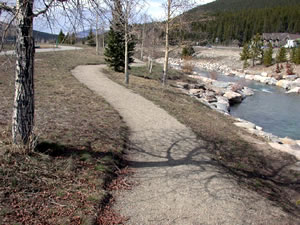Trail Specifications for Accessible Trails
The following data was derived from Trail Design: Best Practices for Accessibility - DRAFT, Beneficial Designs, Inc. , Santa Cruz, California. and Draft Guidelines for New Trail Construction, Americans with Disabilities Act, TT1-TT9, Stuart Macdonald, Colorado State Parks, March, 1999.
 Accessible
trails benefit people with mobility impairments, older adults,
and families with young children. They should enable access to outstanding
or primary features or attractions within a recreational area.
Accessible
trails benefit people with mobility impairments, older adults,
and families with young children. They should enable access to outstanding
or primary features or attractions within a recreational area.
Outdoor Recreation Access Routes, (ORARS) are linkages between primary accessible service elements and developed spaces within outdoor recreation settings. (i.e. restrooms, water, drinking fountains, parking lots, trailheads, camp sites, benches, and scenic viewpoints)
Critical trail access features include grade, cross slope, width, surface, and vertical clearance. Passing spaces should be a minimum of 60 inches by 60 inches.
The maximum grade for an accessible trail should be less than 5% for any distance. Grades can be greater than 5%, but rest areas should be placed at 50 feet maximum intervals above these higher grade sections. The average maximum grade shall be permitted to be 8% where it is not feasible to comply.
Where maximum grades exceed this recommendation, shorter sections with higher maximum grades are acceptable if rest areas are placed closer together and cross-slopes are less than 5% maximum.
Maximum cross slopes should not exceed 3-5% for any distance. Rolling dips and grade dips should be gradual. Rapidly changing grades or dips can flip chairs backwards. Cross slopes can exceed 5% for very short distances, but only if the running grades are kept to less than 5% and rest areas are provided.
The minimum tread width for an accessible trail is 36 inches, but passing space should be provided at a width of 5 feet at least every 300-1000 feet. The clearing width shall be permitted to be reduced to 32 inches where it is not feasible.
Surface material on an accessible trail must be firm enough to resist deformation by the indentation and rotation of the wheels.Protruding obstacles should not exceed 1 inch and gap openings (cracks, etc.) should be less than 0.75 inches if oriented perpendicular to travel or less than 0.50 inches if parallel to the direction of travel.
Tread obstacles shall be permitted to be 2-3 inches maximum where running grades and cross slopes are 5 percent or less or where it is not feasible.